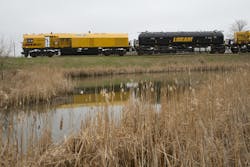Remote Diagnostics Ride the Rails
Monitoring the health of machinery and diagnosing its ills as they occur are challenging enough when the remote assets are standing still. But the challenge is even greater when the more than 80 grinding operations that you are responsible for maintaining are constantly on the move.
Yet this is precisely the challenge that faced Nathan Moyer and his fellow field application technicians at Loram Maintenance of the Way in Hamel, Minn. Loram builds and operates what are essentially sophisticated mobile factories that ride the rails to grind away cracks and other imperfections that would otherwise shorten the life of train tracks. Whenever—and wherever—a problem develops on a traveling factory’s automated grinding modules, the 10-operator crew must rely on the technical support staff at headquarters for help in diagnosing and fixing it.
To offer crews quick and cost-effective support, Loram did what many manufacturing companies had already done. It invested in remote diagnostics, designing the technology into its new line of rail grinders. Its technicians no longer have to travel to an asset in a far-flung location just to assess or troubleshoot problems, and sometimes they can even recommend a fix from afar.
“Without this easy remote access to machine data, troubleshooting and diagnostics on machines in the field were time-consuming and difficult,” Moyer recounts. The technical support staff had to walk the on-site team through the problem and potential fixes. “Larger problems would require the technical staff to travel to the grinder, extending downtime further.”
Another problem solved stemmed from the fact that performance data resided on the machine and was accessible for only 30 days. Because the machines remain in the field for many years or even for their entire lifecycle, technicians from headquarters needed to be proactive in periodically retrieving data from them for routine maintenance. “Retrieving data remotely was a time-consuming task—not to mention that all data was in PLC code, requiring it to be retrieved and analyzed by a technician who could properly interpret the data,” Moyer says.
To streamline access, Loram’s engineering staff worked with Rockwell Automation to design the new RG400 rail grinders for remote diagnostics. Allen-Bradley ControlLogix programmable automation controllers (PACs) oversee the automated modules, and EtherNet/IP links them. FactoryTalk Historian software collects temperatures, running times and other key performance indicators (KPIs) remotely in real time so that Microsoft Surface tablets running the FactoryTalk VantagePoint mobile app can retrieve and display the data.
“Now when I get a call, I can pull up dashboards and trend reports to dig deeper into data logs from my office, at home, or on the road using the Microsoft Surface tablet with wireless connectivity,” Moyer says. “I can also tap into all necessary on-machine HMIs via FactoryTalk View software.” Finding the information that he needs for troubleshooting no longer occupies a significant amount of his time on a job, and he and his colleagues have a practical means for being more proactive and performing predictive maintenance.
Read more about how industrial manufacturers are making use of remote diagnostics. Make sure you understand what you need to know about connections, software and security.
About the Author
James R. Koelsch, contributing writer
Contributing Editor

Leaders relevant to this article:
